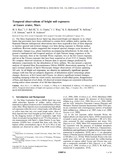| dc.contributor.author | Rice, M. S. | |
| dc.contributor.author | Bell, J. F. III | |
| dc.contributor.author | Cloutis, E. A. | |
| dc.contributor.author | Wray, J. J. | |
| dc.contributor.author | Herkenhoff, K. E. | |
| dc.contributor.author | Sullivan, R. | |
| dc.contributor.author | Johnson, J. R. | |
| dc.contributor.author | Anderson, R. B | |
| dc.date.accessioned | 2018-03-06T19:52:49Z | |
| dc.date.available | 2018-03-06T19:52:49Z | |
| dc.date.issued | 2011-01-27 | |
| dc.identifier.citation | Rice, M.S., J.F. Bell III, E.A. Cloutis, J.J. Wray, K.E. Herkenhoff, R. Sullivan, J.R. Johnson, and R.B. Anderson. "Temporal observations of bright soil exposures at Gusev crater, Mars." Journal of Geophysical Research – Planets, 116 (2011): E00F14. DOI: 10.1029/2010JE003683. | en_US |
| dc.identifier.issn | 2169-9097 | |
| dc.identifier.uri | http://hdl.handle.net/10680/1388 | |
| dc.description.abstract | The Mars Exploration Rover Spirit has discovered bright soil deposits in its wheel tracks that previously have been confirmed to contain ferric sulfates and/or opaline silica. Repeated Pancam multispectral observations have been acquired at four of these deposits to monitor spectral and textural changes over time during exposure to Martian surface conditions. Previous studies suggested that temporal spectral changes occur because of mineralogic changes (e.g., phase transitions accompanying dehydration). In this study, we present a multispectral and temporal analysis of eight Pancam image sequences at the Tyrone exposure, three at the Gertrude Weise exposure, two at the Kit Carson exposure, and ten at the Ulysses exposure that have been acquired as of sol 2132 (1 January 2010). We compare observed variations in Pancam data to spectral changes predicted by laboratory experiments for the dehydration of ferric sulfates. We also present a spectral analysis of repeated Mars Reconnaissance Orbiter HiRISE observations spanning 32 sols and a textural analysis of Spirit Microscopic Imager observations of Ulysses spanning 102 sols. At all bright soil exposures, we observe no statistically significant spectral
changes with time that are uniquely diagnostic of dehydration and/or mineralogic phase changes. However, at Kit Carson and Ulysses, we observe significant textural changes, including slumping within the wheel trench, movement of individual grains, disappearance of fines, and dispersal of soil clods. All observed textural changes are consistent with Aeolian sorting and/or minor amounts of air fall dust deposition. | |
| dc.description.sponsorship | This work is supported by grants and contracts from the NASA Mars Exploration Program (JPL) and the Mars Data Analysis Program (Cornell). M.S.R. was supported by a National Science Foundation Graduate Research Fellowship. E.A.C. and his lab facility are supported by grants from CSA, NSERC, CFI, MRIF, and the University of Winnipeg. J.J.W. thanks the NSF and the Fannie and John Hertz Foundation for support. | |
| dc.description.uri | https://agupubs.onlinelibrary.wiley.com/doi/abs/10.1029/2010JE003683 | |
| dc.language.iso | en | en_US |
| dc.publisher | Journal of Geophysical Research | en_US |
| dc.rights | info:eu-repo/semantics/openAccess | |
| dc.title | Temporal observations of bright soil exposures at Gusev crater, Mars | en_US |
| dc.type | Article | en_US |
| dc.identifier.doi | 10.1029/2010JE003683 | |

